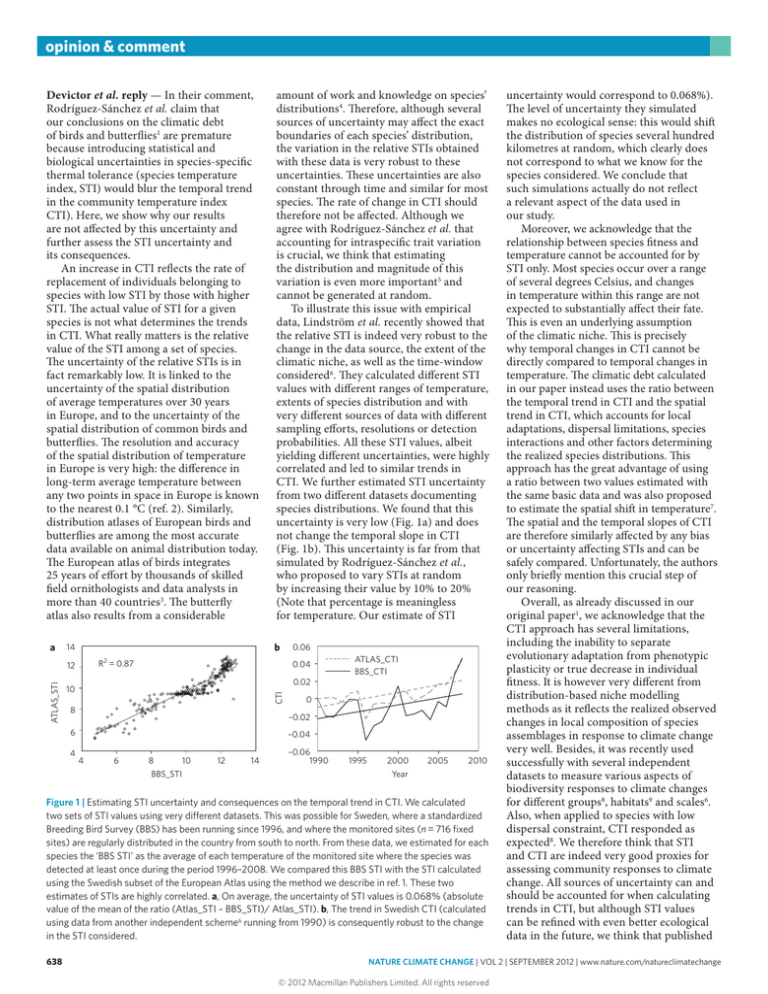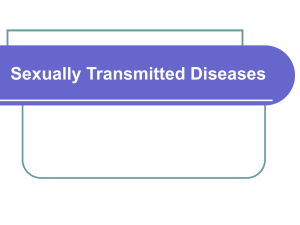
opinion & comment
Devictor et al. reply — In their comment,
Rodríguez-Sánchez et al. claim that
our conclusions on the climatic debt
of birds and butterflies1 are premature
because introducing statistical and
biological uncertainties in species-specific
thermal tolerance (species temperature
index, STI) would blur the temporal trend
in the community temperature index
CTI). Here, we show why our results
are not affected by this uncertainty and
further assess the STI uncertainty and
its consequences.
An increase in CTI reflects the rate of
replacement of individuals belonging to
species with low STI by those with higher
STI. The actual value of STI for a given
species is not what determines the trends
in CTI. What really matters is the relative
value of the STI among a set of species.
The uncertainty of the relative STIs is in
fact remarkably low. It is linked to the
uncertainty of the spatial distribution
of average temperatures over 30 years
in Europe, and to the uncertainty of the
spatial distribution of common birds and
butterflies. The resolution and accuracy
of the spatial distribution of temperature
in Europe is very high: the difference in
long-term average temperature between
any two points in space in Europe is known
to the nearest 0.1 °C (ref. 2). Similarly,
distribution atlases of European birds and
butterflies are among the most accurate
data available on animal distribution today.
The European atlas of birds integrates
25 years of effort by thousands of skilled
field ornithologists and data analysts in
more than 40 countries3. The butterfly
atlas also results from a considerable
a
b
14
2
R = 0.87
0.06
0.04
0.02
10
CTI
ATLAS_STI
12
8
ATLAS_CTI
BBS_CTI
0
–0.02
6
4
amount of work and knowledge on species’
distributions4. Therefore, although several
sources of uncertainty may affect the exact
boundaries of each species’ distribution,
the variation in the relative STIs obtained
with these data is very robust to these
uncertainties. These uncertainties are also
constant through time and similar for most
species. The rate of change in CTI should
therefore not be affected. Although we
agree with Rodríguez-Sánchez et al. that
accounting for intraspecific trait variation
is crucial, we think that estimating
the distribution and magnitude of this
variation is even more important5 and
cannot be generated at random.
To illustrate this issue with empirical
data, Lindström et al. recently showed that
the relative STI is indeed very robust to the
change in the data source, the extent of the
climatic niche, as well as the time-window
considered6. They calculated different STI
values with different ranges of temperature,
extents of species distribution and with
very different sources of data with different
sampling efforts, resolutions or detection
probabilities. All these STI values, albeit
yielding different uncertainties, were highly
correlated and led to similar trends in
CTI. We further estimated STI uncertainty
from two different datasets documenting
species distributions. We found that this
uncertainty is very low (Fig. 1a) and does
not change the temporal slope in CTI
(Fig. 1b). This uncertainty is far from that
simulated by Rodríguez-Sánchez et al.,
who proposed to vary STIs at random
by increasing their value by 10% to 20%
(Note that percentage is meaningless
for temperature. Our estimate of STI
–0.04
4
6
8
BBS_STI
10
12
14
–0.06
1990
1995
2000
2005
2010
Year
Figure 1 | Estimating STI uncertainty and consequences on the temporal trend in CTI. We calculated
two sets of STI values using very different datasets. This was possible for Sweden, where a standardized
Breeding Bird Survey (BBS) has been running since 1996, and where the monitored sites (n = 716 fixed
sites) are regularly distributed in the country from south to north. From these data, we estimated for each
species the ‘BBS STI’ as the average of each temperature of the monitored site where the species was
detected at least once during the period 1996–2008. We compared this BBS STI with the STI calculated
using the Swedish subset of the European Atlas using the method we describe in ref. 1. These two
estimates of STIs are highly correlated. a, On average, the uncertainty of STI values is 0.068% (absolute
value of the mean of the ratio (Atlas_STI – BBS_STI)/ Atlas_STI). b, The trend in Swedish CTI (calculated
using data from another independent scheme6 running from 1990) is consequently robust to the change
in the STI considered.
638
uncertainty would correspond to 0.068%).
The level of uncertainty they simulated
makes no ecological sense: this would shift
the distribution of species several hundred
kilometres at random, which clearly does
not correspond to what we know for the
species considered. We conclude that
such simulations actually do not reflect
a relevant aspect of the data used in
our study.
Moreover, we acknowledge that the
relationship between species fitness and
temperature cannot be accounted for by
STI only. Most species occur over a range
of several degrees Celsius, and changes
in temperature within this range are not
expected to substantially affect their fate.
This is even an underlying assumption
of the climatic niche. This is precisely
why temporal changes in CTI cannot be
directly compared to temporal changes in
temperature. The climatic debt calculated
in our paper instead uses the ratio between
the temporal trend in CTI and the spatial
trend in CTI, which accounts for local
adaptations, dispersal limitations, species
interactions and other factors determining
the realized species distributions. This
approach has the great advantage of using
a ratio between two values estimated with
the same basic data and was also proposed
to estimate the spatial shift in temperature7.
The spatial and the temporal slopes of CTI
are therefore similarly affected by any bias
or uncertainty affecting STIs and can be
safely compared. Unfortunately, the authors
only briefly mention this crucial step of
our reasoning.
Overall, as already discussed in our
original paper1, we acknowledge that the
CTI approach has several limitations,
including the inability to separate
evolutionary adaptation from phenotypic
plasticity or true decrease in individual
fitness. It is however very different from
distribution-based niche modelling
methods as it reflects the realized observed
changes in local composition of species
assemblages in response to climate change
very well. Besides, it was recently used
successfully with several independent
datasets to measure various aspects of
biodiversity responses to climate changes
for different groups8, habitats9 and scales6.
Also, when applied to species with low
dispersal constraint, CTI responded as
expected8. We therefore think that STI
and CTI are indeed very good proxies for
assessing community responses to climate
change. All sources of uncertainty can and
should be accounted for when calculating
trends in CTI, but although STI values
can be refined with even better ecological
data in the future, we think that published
NATURE CLIMATE CHANGE | VOL 2 | SEPTEMBER 2012 | www.nature.com/natureclimatechange
© 2012 Macmillan Publishers Limited. All rights reserved
opinion & comment
results on CTI available with current data
are unlikely to be flawed by major problems
due to STI uncertainty.
❐
Vincent Devictor1*, Chris van Swaay2,
Tom Brereton3, Lluís Brotons4,5,
Dan Chamberlain6, Janne Heliölä7,
Sergi Herrando4, Romain Julliard8,
Mikko Kuussaari7, Åke Lindström9,
Jiří Reif10, David B. Roy11, Oliver Schweiger12,
Josef Settele12, Constantí Stefanescu13,
Arco Van Strien14, Chris Van Turnhout15,16,
Zdeněk Vermouzek17, Michiel Wallis De Vries2,18,
Irma Wynhoff2 and Frédéric Jiguet8
1
Institut des Sciences de l’Evolution, UMR
CNRS-UM2 5554, Montpellier 34095, France,
2
Dutch Butterfly Conservation, PO Box 506,
6700 AM, Wageningen, The Netherlands,
3
Butterfly Conservation, Wareham, BH20
5QP, UK, 4Catalan Ornithological Institute,
08003 Barcelona, Spain, 5Centre Tecnològic
Forestal de Catalunya, 25280 Solsona, Spain,
6
British Trust for Ornithology, Thetford, IP24
2PU, UK, 7Finnish Environment Institute,
PO Box 140, Helsinki FIN-00251, Finland,
8
Conservation des Espèces Restauration
et Suivi des Populations-MNHN, Paris
75005, France, 9Department of Biology,
Lund University, Lund SE-223 62, Sweden,
10
Institute for Environmental Studies,
Charles University in Prague, 128 01, Praha
2, Czech Republic, 11Centre for Ecology and
Hydrology, Wallingford OX10 8BB, UK,
12
UFZ, Helmholtz Centre for Environmental
Research, Department of Community
Ecology, Halle D-06120, Germany, 13Museu
de Granollers Ciències Naturals, E-08400
Granollers, Spain, 14Statistics Netherlands,
PO Box 24500, 2490HA The Hague, The
Netherlands, 15SOVON Dutch Centre for Field
Ornithology, 6573 DG Beek-Ubbergen, The
Netherlands, 16Department of Environmental
Science and Department of Animal Ecology,
Institute for Water and Wetland Research,
Radboud University Nijmegen, PO Box 9010,
6500 GL Nijmegen, The Netherlands,
Czech Society for Ornithology, 150 00,
Praha 5, Czech Republic, 18Laboratory of
Entomology,Wageningen University, PO
Box 8031, 6700 EH, Wageningen,
The Netherlands.
*e-mail: vincent.devictor@univ-montp2.fr
17
References
1. Devictor, V. et al. Nature Clim. Change. 2, 121–124 (2012).
2. Hijmans, R. J. et al. Int. J. Clim. 25, 1965–1978 (2005).
3. Hagemeijer, W. J. M. & Blair, M. J. The EBCC Atlas of European
Breeding Birds: Their Distribution and Abundance (T. & A. D.
Poyser, 1997).
4. Settele, J. et al. BioRisk 2, 33–72 (2009).
5. Albert, C. H. et al. Persp. Plant Ecol. Evol. http://dx.doi.
org/10.1016/j.ppees.2011.04.003 (in the press).
6. Lindström, Å. et al. Ecography http://dx.doi.org/10.1111/j.16000587.2012.07799.x (in the press).
7. Loarie, S. R. et al. Nature 462, 24–31 (2009).
8. Godet, L., Jaffré, M. & Devictor, V. Biol. Lett. 7, 714–717 (2011).
9. Kampichler, C. et al. PLoS One 7, e35272 (2012).
Acknowledgements
We thank Cécile Albert for stimulating comments on the
importance of intraspecific variability and its consequences.
We also thank Francisco Rodríguez-Sánchez and colleagues
for initiating this thought-provoking discussion.
COMMENTARY:
A new paradigm for
climate change
Kevin Anderson and Alice Bows
How climate change science is conducted, communicated and translated into policy must be radically
transformed if ‘dangerous’ climate change is to be averted.
W
ith the Rio+20 conference on
sustainable development now
over, it remains unclear how
much attention policymakers, businesses
and the public paid to scientific analyses
of climate change. A question also
remains as to how impartial, objective
and direct scientists were in presenting
their evidence; politicians may well
have left Rio without understanding the
viability and implications of proposed lowcarbon pathways.
We urgently need to acknowledge that
the development needs of many countries
leave the rich western nations with little
choice but to immediately and severely
curb their greenhouse gas emissions1,2. But
academics may again have contributed
to a misguided belief that commitments
to avoid warming of 2 °C can still be
realized with incremental adjustments to
economic incentives. A carbon tax here, a
little emissions trading there and the odd
voluntary agreement thrown in for good
measure will not be sufficient.
Scientists may argue that it is not
our responsibility anyway and that it is
politicians who are really to blame. The
scientific community can meet next year to
communicate its latest model results and
reiterate how climate change commitments
and economic growth go hand in hand.
Many policymakers (and some scientists)
believe that yet another year will not matter
in the grand scheme of things, but this
overlooks the fundamental tenet of climate
science: emissions are cumulative.
Long-term and end-point targets
(for example, 80% by 2050) have no
scientific basis. What governs future
global temperatures and other adverse
climate impacts are the emissions from
yesterday, today and those released in the
next few years. Delaying an agreement on
NATURE CLIMATE CHANGE | VOL 2 | SEPTEMBER 2012 | www.nature.com/natureclimatechange
© 2012 Macmillan Publishers Limited. All rights reserved
meaningful cuts to emissions increases the
risk of exposing many already vulnerable
communities to higher temperatures
and worsening climate-related impacts.
Yet, behind the cosy rhetoric of naively
optimistic science and policy, there is little
to suggest that existing mitigation proposals
will deliver anything but rising emissions
over the coming decade or two.
Hope and judgement
There are many reasons why climate science
has become intertwined with politics, to the
extent that providing impartial scientific
analysis is increasingly challenging and
challenged. On a personal level, scientists
are human too. Many have chosen to
research climate change because they
believe there is value in applying scientific
rigour to an important global issue. It is
not surprising then that they also hope
that it is still possible to avoid dangerous
639





